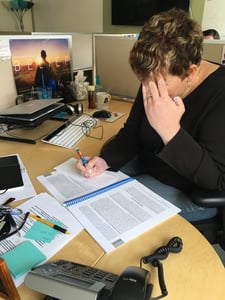
Over the past eleven years, I’ve interacted with a lot of folks who are learning about the CLASS. As they make the leap from not being sure what they have gotten themselves into, to those wonderful “AHA!” moments when they begin using their manuals and are coding with growing confidence, I’ve learned a few ways to make this happen.
As a trainer, I’ve found it helpful to use the icebreaker as a way to help participants begin to face one of the most common challenges to coding. That challenge occurs when people have “opinions.” They look for a certain type of or level of interactions in the classroom. Sometimes they want to “fix” a teacher as they observe, which is a common reaction for coaches or supervisors. This can cause bias and coding errors. Early childhood champions have a lot of opinions! It’s human nature to form an opinion, “Is this good or bad? Would I want this teacher on my staff? There’s too much product-oriented display.” The list goes on and on! The trick is to find a way to help your participants separate these feelings from the evidence they see.
To help them recognize their triggers, I ask participants to write their name on the front of a plain business sized envelope and then write one thing they enjoy seeing in a classroom. On the back, I have them write one thing that challenges them – something they don’t like. Each person shares their name, their work, and their “likes and dislikes” with the group. This tells me a lot about areas that may challenge them, and I make a mental note of this. It also builds a sense of community, as we often share many of the same ideas. As an added bonus, it helps me learn their names! As we go through the exemplars and training videos, the envelopes become a place for them to jot down these triggers: those “halo” and ‘horns” effects that the manual talks about.
Our ideas or feelings about they way things should be in a classroom aren’t necessarily wrong. We all want to see happy, engaged children with caring, sensitive teachers; the trick is to pull our feelings apart from the behaviors we note and decide if they are observable behaviors or if they are feelings. (“That teacher must not like kids. She didn’t smile once!” vs.” The teacher has flat affect.”; “That teacher was so great with the kids.” vs. “The teacher sat on the floor and played with the children as they built a block tower.”) When a participant has a strong reaction to something in a video or exemplar, I ask them to write their feelings on the envelope, and then help them to figure out what the behavior was that they noted and how to write it as observable objective evidence as opposed to their feelings.
This exercise really helps participants see that they DO know what to look for in a classroom, so it has an added bonus of increasing their confidence. CLASS interactions are not some mysterious set of things to look for that were made up by researchers - they are an objective and validated way to measure what is happening during an observation - a way of gathering evidence that helps determine a code. It’s just that participants often need help to write their observations as concrete evidence.
The “envelope, please activity ” becomes a fun, safe place for participants to express their feelings. Writing their feelings down can them recognize a bias or reframe their feelings into CLASS-based evidence during the coding process. Perhaps a participant noted that the teacher didn’t wash her hands after wiping a child’s nose. That would be an envelope moment! If I hear a participant say, “That teacher sent Ryan to time out, for nothing!” I might gently hand them their envelope, or they may write on it and hold it up for the group! I’ve even seen some participants make a comment and then grab their envelope when they recognize a reaction!
So, give it a try, and have some fun with it-- it can be a great way to diffuse a sometimes-tense situation!
Do you have any tips on how to decrease bias during training? Share your facilitation tips in the Facebook group for Affiliate Trainers.

